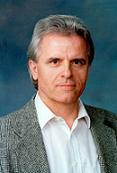Plenary Lecture
The CFD Simulation of Flooding Flows and Scouring Around Bridge Structures
for Improved Design and Stability

Professor M. Kostic
Department of Mechanical Engineering
Northern Illinois University
DeKalb, IL 60115-2854,
USA
Phone: (815) 753-9975 or 753-9979
Fax (815)753-0416
E-mail: kostic@niu.edu
Web site: http://www.kostic.niu.edu
Abstract: The ‘bridge hydraulic analysis
and design’ could be substantially enhanced using advanced commercial
Computational Fluid Dynamics (CFD) software and powerful parallel computing
resources. Key objectives are to evaluate the capabilities of the
state-of-the-art CFD codes for the prediction of experimental results for
lift and drag forces and scouring on inundated bridges, conducted at Turner-Fairbank
Highway Research Center (TFHRC), and the development of “best practices” for
the application of the CFD.
These research activities are part of a multi-year program initiated by
Argonne National Laboratory with the US Department of Transportation (USDOT),
to establish the Transportation Research and Analysis Computing Center (TRACC),
a national supercomputing user facility for advanced computing,
visualization, and high-speed networking, based on a massively parallel
computer system.
Early results have focused on the examination and determination of best
practices, with emphasis on mesh spacing, time step selection and turbulence
modeling. Preliminary two-dimensional model results show reasonable
agreement with limited experimental data. Continuing work will focus on
further development and optimization of the simulation methods and
examination of three-dimensional models.
Future activities will address diverse research needs of the transportation
community in bridge hydraulics, including the assessment of lift and drag
forces on bridge decks when flooded, analysis of sediment transport and its
influence on scouring, optimization of bridge deck-shapes to minimize flow
forces and pressure flow scour, evaluation of active and passive scour
countermeasures, and addressing environmental issues such as fish passage
through culverts.
Brief Biography of the Speaker:
Professor Kostic's teaching and research interests are in Thermodynamics
(a science of energy, the Mother of All Sciences), Fluid Mechanics, Heat
Transfer and related fluid-thermal-energy sciences; with emphases on
physical comprehension and creative design, experimental methods with
computerized data acquisition, and CFD simulation; including nanotechnology
and development of new-hybrid, POLY-nanofluids with enhanced properties, as
well as design, analysis and optimization of fluids-thermal-energy
components and systems in power-conversion, utilizations, manufacturing and
material processing. Dr. Kostic came to Northern Illinois University from
the University of Illinois at Chicago, where he supervised and conducted a
two-year research program in heat transfer and viscoelastic fluid flows,
after working for some time in industry.
"Kostic’s unique synergy of philosophical, theoretical, computational and
experimental approach, results in open mind, intense curiosity and sharp
focus for identifying and analyzing natural and engineering phenomena with
high motivation for problem identification, troubleshooting and solving."
Kostic received his B.S. degree with the University of Belgrade Award as the
best graduated student in 1975. Then he worked as a researcher in thermal
engineering and combustion at The Vinca Institute for Nuclear Sciences,
which then hosted the headquarters of the International Center for Heat and
Mass Transfer, and later taught at the University of Belgrade in
ex-Yugoslavia (*). He came to the University of Illinois at Chicago in 1981
as a Fulbright grantee, where he received his Ph.D. in mechanical
engineering in 1984. Subsequently, Dr. Kostic worked several years in
industry. In addition, he spent three summers as an exchange visitor in
England, West Germany, and the former Soviet Union.
Dr. Kostic has received recognized professional fellowships and awards,
including multiple citations in Marquis' "Who's Who in the World" and "Who's
Who in Science and Engineering"; the Fulbright Grant; NASA Faculty
Fellowship; Sabbatical Semester at Fermilab as a Guest Scientist; and the
summer Faculty Research Participation Program at Argonne National
Laboratory. He is a frequent reviewer of professional works and books in
Thermodynamics and Experimental Methods. Dr. Kostic is a licensed
professional engineer (PE) in Illinois and a member of the ASME, ASEE, and
AIP's Society of Rheology. He has a number of publications in refereed
journals, including invited state-of-the-art chapters in the Academic Press
series Advances in Heat Transfer, Volume 19, and "Viscosity" in CRC Press'
Measurement, Instrumentation and Sensors Handbook; as well as invited
reference articles: Work, Power, and Energy in Academic Press/Elsevier's
Encyclopedia of Energy; Extrusion Die Design in Dekker's Encyclopedia of
Chemical Processing; and Energy: Global and Historical Background and
Physics of Energy in Taylor & Francis/CRC Press Encyclopedia of Energy
Engineering and Technology. Professor Kostic is a member of the Graduate
Faculty at Northern Illinois University . More at: http://www.kostic.niu.edu